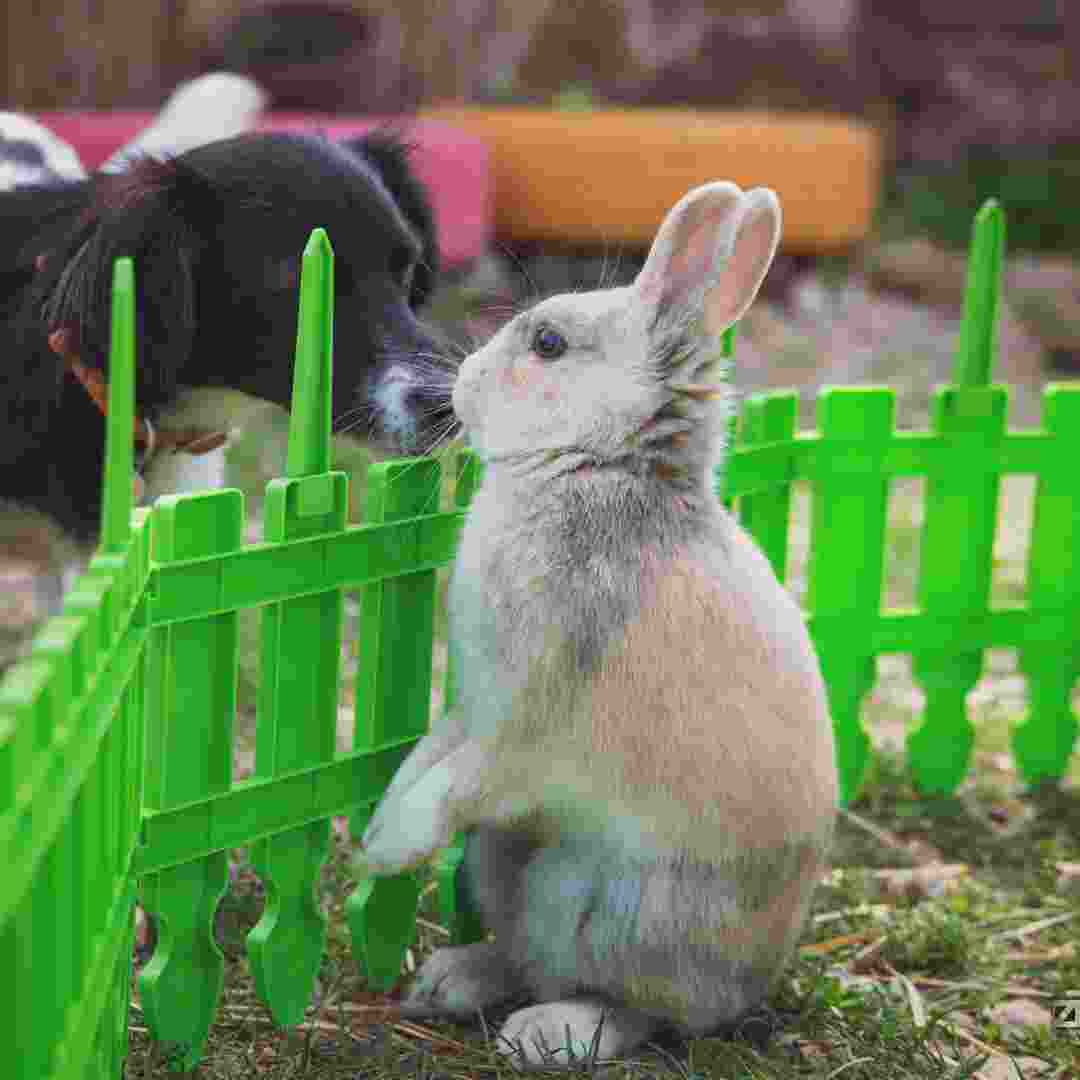Contents Table
Introduction
Introduction of Rabbit and Dog: Tips for a Smooth Transition
Rabbit and Dog in the Same House: Pros and Cons
What to Do If Your Rabbit and Dog Fight
Teaching Your Dog to Respect Your Rabbit's Space
Rabbit and Dog Body Language: Compatibility and Conflict
Q&A
Conclusion
Introduction
Rabbits and dogs are terrific pets, but they have different needs. Understanding their needs and providing the right habitat and care can help rabbits and dogs coexist. Rabbits and dogs can become buddies with proper introduction and training.
Introduction of Rabbit and Dog: Tips for a Smooth Transition
Introducing a rabbit and a dog might be difficult, but with preparation and patient, it can be rewarding. Tips for a smooth transition:
1. Introduce animals in separate, neutral locations. Both animals will get used to each other's scent and presence without feeling intimidated.
2. Let animals get acclimated to each other slowly. First let them see one other from afar, then go closer.
3. Monitor all animal interactions. This will help keep animals calm and resolve disagreements fast.
4. Give animals many distractions. To avoid boredom and aggression, toys, snacks, and other activities can keep animals busy.
5. Give both animals space. This will reassure them and reduce territorial disputes.
These suggestions will help you introduce a rabbit and a dog smoothly. Be patient and empathetic to establish a safe and pleasant habitat for both animals.
Rabbit and Dog in the Same House: Pros and Cons
Living with a rabbit and a dog can benefit both animals and their owners. Before bringing both animals home, weigh the advantages and downsides.
The main benefit of having a rabbit and a dog together is companionship. Social rabbits build deep ties with other animals, especially canines. This can calm both animals and provide them security. Another benefit of owning two pets is double the love and affection.
However, having a rabbit and a dog together may have drawbacks. Dogs are predators and may hunt on rabbits. The dog may chase or attack the rabbit, causing danger. Rabbits are also easily scared by loud noises and quick movements like dogs.
Take steps to protect both animals. This involves giving the rabbit a safe enclosure the dog cannot access and lots of space to explore. To minimise hostility, give both animals lots of love and attention.
Having a rabbit and a dog together can benefit both animals and owners. However, dangers must be considered and steps taken to protect both animals. Both animals can attach and adore each other with proper care.
What to Do If Your Rabbit and Dog Fight
Pet owners often struggle when a rabbit and a dog don't get along. To protect animals and foster peace, do the appropriate procedures. Here are some rabbit-dog conflict resolution tips:
Step 1: Separate the animals. This will prevent injuries and protect both animals. Keep pets in separate rooms or parts of the house.
2. Introduce them carefully: After separating the animals, introduce them cautiously. Start by letting them see each other from away. Slowly extend their distance till they're comfortable.
3. Provide distractions when introducing animals. Toys, snacks, and other activities can keep animals busy and apart.
4. Monitor interactions: Animals should be supervised when together. This will prevent animal aggression.
5. Train animals: Training animals reduces hostility. Learning animal instructions like sit, stay, and come can help calm the surroundings.
Pet owners can help their rabbit and dog relax by following these instructions. The animals may need time to become used to each together, but with patience and persistence, they can form a pleasant connection.
Teaching Your Dog to Respect Your Rabbit's Space
Maintaining your rabbit's safety and happiness requires training your dog to respect its area. Remember that rabbits and dogs have distinct needs and behaviours, so it's up to you to keep their interactions safe and courteous.
To teach your dog to respect your rabbit's space, start with a safe atmosphere. Make sure your rabbit's cage is out of reach of your dog. If your rabbit is free, always supervise your dog. If your dog is unsupervised, use a baby gate or fence to separate them.
Next, teach your dog to respect your rabbit's space. Start by teaching your dog "sit," "stay," and "leave it." Before letting your dog play with your rabbit, be sure he understands these commands. When your dog obeys you around your bunny, praise him.
Also, teach your dog to be gentle with your bunny. Your dog's roughness can seriously injure your bunny. Praise your dog for being kind and respectful.
Finally, remember that rabbits and dogs have different demands and behaviours. To engage your rabbit, provide lots of hiding spots and toys. A secure area for your rabbit to withdraw to when anxious or overwhelmed is essential.
These methods can help your dog and rabbit coexist together and safely. You can learn your dog to respect your rabbit's space and make both animals happy and safe with patience and persistence.
Rabbit and Dog Body Language: Compatibility and Conflict
Understanding rabbit and dog body language requires recognising compatibility and conflict. Owners may keep their pets safe and happy by recognising these signals.
Rabbits and dogs can get along if you know their body language. Rabbits and dogs that get along are usually calm and relaxed. The dog may be wagging or lying down, while the rabbit may be grooming or exploring.
Rabbits and dogs may fight if they don't get along. Rabbit pounding hind legs, dog barking or growling. The rabbit crouching and flattening its ears and the dog raising its hackles are also visible.
Note that rabbits and dogs can show fear or nervousness. The rabbit may tremble or hide, while the dog may cower or avoid eye contact.
Monitor rabbit-dog interactions to guarantee compatibility. If animals show aggressiveness or fear, separate them and give them space. To keep them cognitively and physically busy, both animals need lots of exercise and enrichment.
By reading rabbit and dog body language, owners can keep their pets secure and happy. Owners may ensure their pets get along and receive the greatest care by recognising compatibility and conflict indications.

Q&A
1. Do rabbits and dogs get along?
If introduced and socialised, bunnies and dogs can get along. It's crucial to oversee rabbit-dog interactions and offer a safe environment because they have different requirements and behaviours.
2. How do I introduce my dog and rabbit?
You must cautiously introduce your rabbit and dog. Allow them to scent one other from afar and gradually increase their time together. Give both animals lots of food and praise.
3. What should I do if my rabbit and dog fight?
If your rabbit and dog don't get along, separate them and keep them secure. Also consult a veterinarian or animal behaviourist to assess the best course of action.
4. Are there rabbit-friendly dog breeds?
Yes, some dog breeds are better with bunnies. Labradors, Poodles, and Golden Retrievers are friendly and patient with other animals.
5. What should I do if my rabbit and dog fight?
If your rabbit and dog quarrel, separate them immediately. Make sure both animals are safe and consult a vet or animal behaviourist for the best course of action.
Conclusion
Finally, properly introduced and socialised bunnies and dogs can get along. Remember that rabbits and dogs have different requirements and behaviours, so take the time to understand them and establish a safe and comfortable environment for them. Through patience and compassion, bunnies and dogs can be terrific friends.
